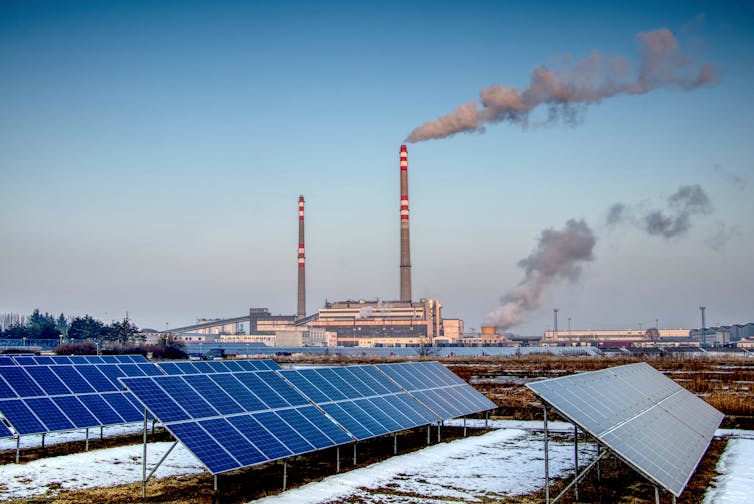Without changes, Scheer's climate plan will be expensive or ineffective: ŔĎËľ»úÖ±˛Ą expert

Published: June 26, 2019
When , he said he could eliminate the federal carbon tax and still meet Canada’s emissions targets by focusing on investments in green technology. Tech, not taxes, he said.
Under the plan, major emitters would not pay a carbon tax and would, instead, have to invest in “emissions-reducing technology.” But if you look closer, these investments may not actually reduce emissions.
Instead of investing in proven green technology such as wind farms and solar power, Scheer’s plan allows industries to fund things with the potential to reduce emissions, like research or green companies. This flexibility reduces the guaranteed benefits of these green investments.
Although the details remain sparse, Scheer’s proposal isn’t entirely off base: My own research shows that investment into green technologies can offset the emissions of an entire industry, but it can only work in certain circumstances. With a couple of modifications, policies like Scheer’s can bring more predictable and affordable emissions reductions.
A disguised carbon tax
Scheer’s plan includes “” that would force major emitters to invest a set amount, based on their emissions. Investments must go to activities, technologies, companies or research that might eventually reduce emissions.

These mandatory investments would create financial pressure to lower emissions, much like a carbon tax. But, unlike many carbon taxes, these investments aim to reduce emissions in the “medium term,” according to Scheer.
It’s not clear how long that might be or what the investment amounts will be. Surprisingly, the standards let emitters invest in indirect emissions reductions, including funding research or purchasing a clean-tech start-up company.
Allowing investments that do not create substantial short-term emissions reductions creates a major loophole. For example, a $1-million factory expansion that also reduced factory emissions by 0.01 per cent might be considered an eligible investment under Scheer’s plan, but that $1 million would have little effect on emissions.
Scheer could improve his plan with this change: Make explicit emissions-reduction targets for investments, and let the private sector innovate and find cheaper paths to those targets.
Affordable or effective?
. Defined costs, like a carbon tax, where fixed financial penalties encourage greener choices, but the benefits can vary. Or, defined benefits, like cap-and-trade, where regulations require emissions to change, but the costs can vary.
While , Scheer is proposing a new policy structure without providing details. Without details, Scheer’s plan may seem like the best of both a carbon tax and a cap-and-trade system. But without firm emissions-reduction targets, Scheer’s policy relies on its financial incentives for emissions reductions and will behave like a carbon tax.
To be effective, therefore, the required investments per tonne of emissions in Scheer’s plan would need to be similar to the per tonne costs of the carbon tax. Yet Scheer decries projections that an effective federal carbon tax would need to climb north of $100 per tonne. Both Scheer’s plan and the federal carbon tax rely on financial incentives to reduce emissions. Either policy will force Canadians to choose between an affordable climate policy and an effective one.
My research team has found a way to ease this dilemma. With a couple of modifications, the efficiency of policies like Scheer’s can be improved by as much as five times.
A savings opportunity
We looked at what would happen to emissions if fossil fuel producers were forced to invest in green technologies that were known to be profitable or save costs, and were further required to reinvest a portion of those profits or cost savings. We created a simulation where oil and gas producers in North Dakota were forced to invest in wind turbines – and reinvest a fraction of the wind turbines’ revenue into more wind turbines.

The initial investments in wind turbines turned a profit and some of that profit went towards growing the wind farm. This feedback loop allowed the wind farm and its emissions offsets to grow exponentially and reduced the necessary initial investments. In North Dakota, .
Combining investment and reinvestment into proven and successful green technologies allows green technologies to expand more quickly. Policies with reinvestment are like a savings account with a high interest rate – over time, the balance is funded by more than the initial investment.
Reinvestment makes green technologies and their emissions reductions available at a lower cost to consumers and businesses. Owning profitable and growing green technologies gives businesses, consumers and heavy emitters a transition plan, which my colleagues and I call “black-into-green,” or the BIG transition.
Mandate reinvestments
While our case study is not directly applicable everywhere (and due to lower wind speeds and greener Canadian electricity), it demonstrates the benefits of pairing investments and reinvestments into profitable or cost-saving green technologies.
Our work suggests Scheer should make another modification to his plan: The green investment standards should mandate that heavy emitters make profitable or cost-saving green investments and reinvest a portion of those profits or savings.
Scheer’s green investment plan is missing key details and needs two major improvements. The Conservatives should mandate the efficacy of investments and require reinvestments. Without these modifications, the proposed green investment standards, like a carbon tax, are another climate policy that can be either affordable or effective – but not both.
Given this trade-off, Canadians should fear promises of affordability and advocate more efficient climate policies.![]()
is an assistant professor in the department of civil and mineral engineering at the .
This article is republished from under a Creative Commons license. Read the .



